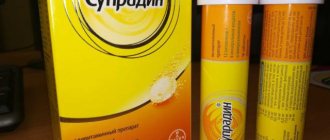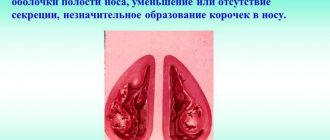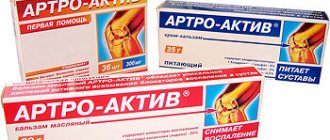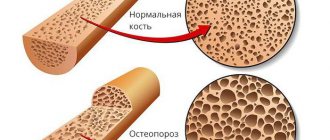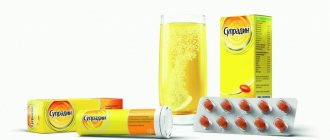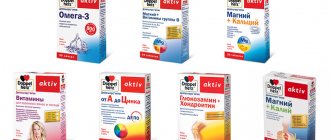Release form and composition
The dosage form of Vicks Active SymptoMax is a powder for the preparation of a solution for oral administration: finely crystalline; lemon - light yellow, with a characteristic odor of lemon, the prepared solution is yellow, with opalescence, with a characteristic odor of lemon; blackcurrant - light purple, with a characteristic smell of black currant, the prepared solution is red-violet, with a characteristic smell of black currant (5 g in laminated bags, 5 or 10 bags in a cardboard pack).
Active ingredients in 1 sachet (5 g) of powder:
- phenylephrine hydrochloride – 12.2 mg;
- paracetamol – 1000 mg.
Auxiliary components (lemon/blackcurrant powder): ascorbic acid – 100/100 mg; sucrose – 1936/2351 mg; citric acid – 812/812 mg; sodium citrate – 501/501 mg; aspartame – 25/53 mg; acesulfame potassium – 65/51 mg; quinoline yellow dye – 1/0 mg; lemon flavor F/501.476/AP0504 – 40/0 mg; lemon flavor F/29088 – 30/0 mg; lemon flavor F/28151 – 240/0 mg; lemon flavor F/29089 – 240/0 mg; blackcurrant dye – 0/6 mg; blackcurrant flavor 1007348 – 0/60 mg; blackcurrant flavor S-133747 – 0/56 mg.
Pharmacological properties
Pharmacodynamics
Vicks Active SymptoMax is a combination drug; its effect is due to the properties of its constituent components:
- paracetamol: has antipyretic and analgesic effects. These effects are due to inhibition of prostaglandin synthesis in the central nervous system;
- phenylephrine: is a postsynaptic alpha-adrenergic agonist with low cardioselective affinity for beta-adrenergic receptors; is one of the anti-edematous drugs; eliminates hyperemia and swelling of the nasal mucosa, constricts blood vessels.
Pharmacokinetics
Paracetamol
Completely and quickly absorbed from the small intestine. Cmax (maximum concentration of the substance) in the blood is reached 15–20 minutes after ingestion. Its systemic bioavailability is determined by first-pass metabolism and can range from 70–90% (depending on the dose). Distributes quickly throughout all tissues of the body.
The half-life is approximately 2 hours. Metabolized in the liver, more than 80% of the substance is excreted in the form of sulfate compounds and glucuronides in the urine.
Phenylephrine
Rapidly absorbed from the gastrointestinal tract. Time to reach Cmax is 1–2 hours.
During the first pass through the liver, the rate of metabolism of phenylephrine is quite high (approximately 60%), and therefore its bioavailability is reduced when administered orally (approximately 40%).
The half-life is in the range of 2–3 hours. It is excreted in the form of sulfate compounds in the urine.
Pharmacokinetics
Vicks Active effervescent tablets are well absorbed from the digestive tract. Due to the initial passage through the liver, the absolute bioavailability of the drug is reduced by 10%. Reaches maximum concentration in blood plasma after 1-3 hours. Acetylcysteine is able to penetrate the placenta and accumulate in amniotic fluid.
During metabolism, it breaks down into cysteine, cyacetic cysteine, cystine and disulfides. It is excreted in the form of inactive metabolites by the kidneys. A small part is excreted along with feces.
In patients with impaired liver function, the maximum concentration of the active component in the blood plasma is observed after 8 hours.
Contraindications
Absolute:
- arterial hypertension;
- cardiac ischemia;
- severe renal dysfunction;
- impaired liver function;
- glaucoma;
- prostatic hyperplasia;
- diabetes;
- hyperthyroidism;
- sucrase/isomaltase deficiency, glucose-galactose malabsorption;
- fructose intolerance;
- phenylketonuria (associated with aspartame included in the drug);
- combined use with tricyclic antidepressants, monoamine oxidase inhibitors, beta-blockers or their use within the previous 14 days;
- pregnancy and breastfeeding;
- age under 18 years;
- individual intolerance to the components of the drug.
Long-term use of the drug is not recommended. Concomitant use with other anti-cold/paracetamol-containing medications is not recommended. You should not take the drug at the same time as alcohol.
Relative (diseases/conditions in which the use of Vicks Active SymptoMax requires caution):
- chronic obstructive pulmonary disease;
- bronchial asthma;
- deficiency of glucose-6-phosphate dehydrogenase;
- hyperoxaluria;
- blood diseases;
- congenital hyperbilirubinemia (Dubin-Johnson, Gilbert, Rotor syndromes).
Indications for use
- Acute and chronic bronchitis;
- Pathological conditions accompanied by the formation of difficult to separate viscous mucopurulent sputum;
- Bronchiolitis;
- Pneumonia;
- Bronchial asthma;
- Tracheitis that develops against the background of a viral or bacterial infection;
- Bronchiectasis;
- Blockage of the bronchi with mucus plug;
- Cystic fibrosis (as a complex therapy drug);
- Post-traumatic and post-operative conditions;
- Purulent and catarrhal otitis;
- Various forms of sinusitis (to facilitate the passage of mucous secretions);
- Paracetamol overdose.
Instructions for use of Vicks Active SymptoMax: method and dosage
Vicks Active SymptoMax powder is taken orally.
Single dose – 1 sachet. You must first dissolve its contents with 250 ml of hot, but not boiling, water. The solution is taken after it has cooled to an acceptable temperature.
If necessary, Vicks Active SymptoMax can be taken every 4–6 hours, but not more than 4 times a day.
Recommended duration of use (without medical advice):
- as an anesthetic – 5 days;
- as an antipyretic – 3 days.
If symptoms persist, consultation with a doctor is indicated.
Directions for use and doses
The tablets are taken after meals, after first dissolving in water.
The drug at a dosage of 600 mg is recommended for adults and children over 14 years of age. A whole or ½ tablet is prescribed, 2-3 times a day. The maximum daily dose should not exceed 600 mg.
A tablet drug with a dosage of 200 mg is prescribed to adults and children over 14 years of age, 1 tablet 2-3 times a day. Daily dose 400-600 mg.
Children from 6 to 14 years old – 1 tablet (200 mg) 2 times a day. Daily dose 400 mg.
Children from 2 to 6 years old – ½ tablet 2-3 times a day (no more than 200-300 mg per day).
When treating cystic fibrosis, children aged 2 to 6 years are prescribed 100 mg of the drug (1/2 tablet) 4 times a day.
Children over 6 years old – 1 tablet (200 mg) 3 times a day.
Chronic cystic fibrosis may require long-term use of this drug.
Side effects
Phenylephrine
- cardiovascular system: rarely – tachycardia, increased blood pressure;
- nervous system: rarely - nervousness, anxiety, tremor, confusion, insomnia, increased excitability, headache, irritability;
- digestive system: often – vomiting, anorexia, nausea;
- allergic reactions: rarely - allergic reactions, including skin rash, bronchospasm, anaphylaxis, urticaria.
Paracetamol
- urinary system: rarely – nephrotoxicity, urinary retention;
- central nervous system: rarely – dizziness;
- digestive system: rarely - hepatotoxic effect, vomiting, nausea, dryness of the oral mucosa;
- hematopoietic system: rarely – methemoglobinemia, aplastic anemia, increased blood pressure; very rarely - pathological changes in the blood, including thrombocytopenia, agranulocytosis, hemolytic anemia, neutropenia, leukopenia, pancytopenia;
- allergic reactions: rarely - urticaria, skin rash, anaphylaxis, angioedema, bronchospasm;
- others: rarely - increased intraocular pressure, accommodation paresis, mydriasis.
Overdose
The main symptoms of paracetamol overdose:
- more than 10 g: liver damage;
- more than 5 g: liver damage in the presence of risk factors (alcohol abuse, long-term therapy with primidone, carbamazepine, phenytoin, phenobarbital, rifampicin or other drugs that induce liver enzymes, cystic fibrosis, cachexia, fasting, glutathione deficiency, HIV infection).
Disturbances manifest themselves as pale skin, vomiting, nausea, abdominal pain, anorexia. They may occur within 12–48 hours after taking the drug. It is possible to develop only individual symptoms (for example, only vomiting or nausea), which may not reflect the actual degree of risk of organ damage.
Symptoms of severe overdose: coma, liver failure in combination with progressive encephalopathy, pancreatitis, arrhythmia, acute renal failure in combination with tubular necrosis (including in the absence of severe liver damage), death.
Symptoms of phenylephrine overdose: irritability, headache, increased blood pressure.
In cases of overdose of Vicks Active SymptoMax, regardless of the presence/absence of primary symptoms, you should consult a doctor. In order to prevent severe consequences, measures should be taken, including the introduction of SH-group donors and precursors for glutathione synthesis - methionine (for 8-9 hours after an overdose) and acetylcysteine (for 8 hours). The need for additional measures is determined by the doctor individually based on the concentration of paracetamol in the blood, as well as the time that has passed since taking increased doses of the drug.
Vicks Active SymptoMax
Dissolve the contents of one sachet in hot but not boiling water (250 ml). Allow to cool to an acceptable temperature and drink.
For adults and children over 18 years of age, a single dose is 1 sachet. If necessary, the drug can be taken every 4-6 hours, but not more than 4 doses (sachets) per day.
The drug is not recommended for use for more than 5 days as an analgesic and 3 days as an antipyretic without consulting a doctor. If symptoms persist, the patient should consult a doctor.
Overdose
Symptoms: liver damage is possible in adults who have taken paracetamol in amounts of 10 g or more. Taking paracetamol in amounts of 5 g or more can cause liver damage if there are risk factors: long-term treatment with carbamazepine, phenobarbital, phenytoin, primidone, rifampicin or other drugs that induce liver enzymes, alcohol abuse, glutathione deficiency (for example, poor diet), cystic fibrosis , HIV infection, fasting, cachexia. Pale skin, nausea, vomiting, anorexia and abdominal pain. Liver damage may appear within 12 to 48 hours after taking the drug. Symptoms may only appear partially as nausea or vomiting, and may not reflect the actual extent of overdose or the risk of organ damage. In case of severe overdose - liver failure with progressive encephalopathy, coma, death; acute renal failure with tubular necrosis (including in the absence of severe liver damage); arrhythmia, pancreatitis.
Symptoms of a phenylephrine overdose include irritability, headache, increased blood pressure (if these symptoms occur, consult a doctor).
Treatment: despite the absence of primary symptoms of overdose, it is necessary to seek qualified help from medical institutions. To prevent the severe consequences of an overdose, the necessary measures should be taken in a timely manner. Administration of SH-group donors and precursors for the synthesis of glutathione - methionine within 8-9 hours after an overdose and acetylcysteine - within 8 hours. The need for additional therapeutic measures (further administration of methionine, intravenous administration of acetylcysteine) is determined depending on the concentration of paracetamol in the blood, as well as on the time elapsed after its administration.
special instructions
It is recommended to refrain from taking anxiolytic and hypnotic drugs, as well as other drugs containing paracetamol during therapy.
Vicks Active SymptoMax distorts the results of laboratory tests to determine the concentration of uric acid and glucose in plasma.
Impact on the ability to drive vehicles and complex mechanisms
When driving vehicles, patients should take into account the possibility of an individual reaction, including the risk of confusion and dizziness.
Pharmacodynamics
A drug for internal use that has secretomotor (stimulating expectoration) and secretolytic effects. It thins, increases volume and facilitates the removal of mucus. Remains active in the presence of mucopurulent mucolytic secretion.
The mechanism of action of Vicks Active effervescent tablets is based on the ability of the sulfide groups of the active component to break the disulfide bonds of acidic mucopolysaccharides of sputum. As a result, mucoproteins are depolarized and mucus viscosity decreases.
Under the influence of acetylcysteine, the synthesis of glutathione (an important antioxidant factor of intracellular protection that supports the functional activity and morphological integrity of the cell) increases. At the same time, this substance has an antioxidant effect, suppresses the formation of free radicals and reactive oxygen-containing substances that contribute to the development of inflammation in the lung tissue.
Drug interactions
Phenylephrine
- antidepressants, phenothiazine derivatives, antiparkinsonian and antipsychotic drugs: development of urinary retention, dryness of the oral mucosa, constipation;
- glucocorticosteroids: increased likelihood of glaucoma;
- halothane: increased risk of ventricular arrhythmia;
- tricyclic antidepressants: increased adrenomimetic effect of phenylephrine.
Paracetamol
- ethanol, phenytoin, barbiturates, rifampicin, flumecinol, tricyclic antidepressants, phenylbutazone and other stimulants of microsomal oxidation in the liver: increased production of hydroxylated active metabolites, which can cause severe intoxication;
- warfarin and other coumarin derivatives: enhancing their anticoagulant effect (against the background of prolonged use of paracetamol);
- indirect anticoagulants: enhancing their effect;
- metoclopramide, domperidone: increase the rate of absorption of paracetamol;
- uricosuric drugs: decrease in their effectiveness;
- cholestyramine: decreased rate of absorption of paracetamol;
- monoamine oxidase inhibitors, sedatives, ethanol: enhancing their effects.


